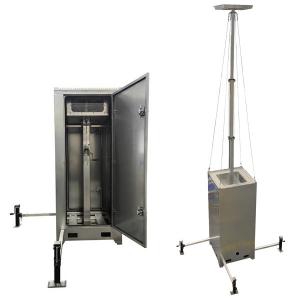

Add to Cart
Customized mobile surveillance units with LED lighting and camera secturity
Quickly Details:
Customized design:
The customer can custom the solar panels, the batteries and the mast height. For the camera, different countries have different standards for cameras, and the price is different. If the customer needs camera light tower, suggest you purchase the camera in your local market, or you can buy it locally and then send it to us, we'll install it for you. In a word, locally purchased cameras are recommended.
The box body can be customized according to the customer's drawings
and requirements, the box material is steel, can be cold galvanized
or hot galvanized according to the requirements, the main purpose
of the galvanized layer is to enhance the anti-corrosion ability,
so that the box even exposed to the outdoors, but also has a long
service life.
The simple box can be equipped with a manual mast, the main purpose is to lift the camera or LED lights; The four sides of the box can also be installed with solar panels, the power can be customized, the battery can be installed inside the box, and the overall equipment can be used as a solar new energy power station.
Feature:
Boasting a small footprint for versatile placement, the cube mobile surveillance unit is designed for easy relocation using a forklift. Its integrated outriggers ensure stable positioning and effortless leveling, guaranteeing optimal surveillance coverage with simplicity and convenience.
Equipment surface cold galvanized hot galvanized can be selected,
the difference is as follows:
Two popular types of galvanizing are cold galvanizing (also known as electro-galvanizing) and hot-dip galvanizing. Despite being used for the same purpose, these two methods differ in their processes, costs, and effectiveness.
One of the significant differences between cold and hot galvanizing is the method of application. Cold galvanizing uses an electric current to bond the zinc layer onto the material, whereas hot-dip galvanizing involves dipping the material into a bath of molten zinc. This process results in a thicker and more durable zinc coating that offers long-term protection.
Another aspect where cold and hot galvanizing differs is their cost-effectiveness. Cold galvanizing is comparatively cheaper than hot-dip galvanizing as it requires less equipment and material. However, hot-dip galvanizing offers better value for money in the long run as it provides longer-lasting protection against rust and corrosion.
In terms of appearance, the final product of cold galvanizing results in a matte finish, while hot-dip galvanizing gives a shiny and smooth surface. This makes hot-dip galvanizing the preferred method for applications that require an attractive finish.
Despite the differences, both cold and hot galvanizing offer strong protective measures against corrosion and rust. They are widely used in various industries, including construction, automotive, and agriculture. Therefore, choosing between cold and hot galvanizing depends on the specific needs, budget, and end-use of the product.
In conclusion, both cold and hot galvanizing are effective ways of protecting materials from corrosion and rust. While their methods and costs differ, they both provide long-lasting protection to increase the durability of materials. Therefore, it is essential to weigh the benefits and drawbacks of each method before deciding the best option for your needs.
Simple Specification:
Box size:
| Expand size | 2200*2200*7000mm |
| External dimension | 1300*1300*2300mm |
| Packing size | 1000*1000*2300mm |
| Surface treatment | cold galvanized or hot galvanized |
Pictures:
